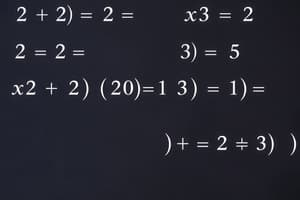Podcast
Questions and Answers
Which of the following statements about the nth root of a real number ( x ) is always true?
Which of the following statements about the nth root of a real number ( x ) is always true?
- If \( n \) is even, \( x \) must be non-negative for the result to be a real number. (correct)
- If \( n \) is even, \( x \) can be any real number.
- The nth root of \( x \) is equivalent to \( x^n \).
- If \( n \) is odd, \( x \) must be non-negative.
Given the expression ( \sqrt[m]{\sqrt[n]{a}} ), which of the following is an equivalent form?
Given the expression ( \sqrt[m]{\sqrt[n]{a}} ), which of the following is an equivalent form?
- $a^{m+n}$
- $\sqrt[mn]{a}$ (correct)
- $\sqrt[m+n]{a}$
- $(\sqrt[n]{a})^m$
Which of these expressions demonstrates a correct application of the product property of radicals?
Which of these expressions demonstrates a correct application of the product property of radicals?
- $\sqrt{16 + 9} = \sqrt{16} + \sqrt{9} = 4 + 3 = 7$
- $\sqrt[3]{8 \cdot 27} = \sqrt[3]{8} \cdot \sqrt[3]{27} = 2 \cdot 3 = 6$ (correct)
- $\sqrt[3]{(-8)(27)} = \sqrt[3]{-8} + \sqrt[3]{27} = -2 + 3 = 1$
- $\sqrt{-4} \cdot \sqrt{-9} = \sqrt{(-4)(-9)} = \sqrt{36} = 6$
What is the simplified form of the expression ( \sqrt[3]{54x^4y^6} )?
What is the simplified form of the expression ( \sqrt[3]{54x^4y^6} )?
Which expression is equivalent to ( (\sqrt[5]{a^2b^3})^4 )?
Which expression is equivalent to ( (\sqrt[5]{a^2b^3})^4 )?
Simplify the expression $\sqrt[3]{(-2)^3}$ and determine the correct application of the nth root property.
Simplify the expression $\sqrt[3]{(-2)^3}$ and determine the correct application of the nth root property.
Consider the expression $9^{-\frac{3}{2}}$. Which of the following steps correctly simplifies the expression using properties of rational exponents?
Consider the expression $9^{-\frac{3}{2}}$. Which of the following steps correctly simplifies the expression using properties of rational exponents?
Given the equation $\sqrt{2x + 5} = x - 5$, identify the correct solutions after checking for extraneous roots.
Given the equation $\sqrt{2x + 5} = x - 5$, identify the correct solutions after checking for extraneous roots.
Simplify the expression $\sqrt{-16} + \sqrt{-25}$ using complex numbers.
Simplify the expression $\sqrt{-16} + \sqrt{-25}$ using complex numbers.
Which of the following equations demonstrates the inverse property of nth powers and nth roots, assuming x is non-negative?
Which of the following equations demonstrates the inverse property of nth powers and nth roots, assuming x is non-negative?
Flashcards
Square Root
Square Root
A value that, when multiplied by itself, equals the original number.
Radical
Radical
An expression that includes a root (square root, cube root, etc.).
nth Root
nth Root
The value that, when raised to the nth power, equals the original number.
Product Property of Radicals
Product Property of Radicals
Signup and view all the flashcards
Simplifying Radicals
Simplifying Radicals
Signup and view all the flashcards
Rational Exponent
Rational Exponent
Signup and view all the flashcards
Complex Number
Complex Number
Signup and view all the flashcards
Radical Equation
Radical Equation
Signup and view all the flashcards
Extraneous Solutions
Extraneous Solutions
Signup and view all the flashcards
Inverse Properties of nth Powers and nth Roots
Inverse Properties of nth Powers and nth Roots
Signup and view all the flashcards
Study Notes
- Square roots and radicals are fundamental concepts in algebra, particularly in Algebra 2, with nth roots generalizing the idea of square roots.
Square Roots
- The square root of a number ( x ) is a value that, when multiplied by itself, equals ( x ).
- ( \sqrt{x} ) denotes the principal (non-negative) square root of ( x ).
- Example: ( \sqrt{9} = 3 ) because ( 3 \times 3 = 9 ).
- For real numbers, the square root of a negative number is not a real number (it is an imaginary number).
- The square root function ( f(x) = \sqrt{x} ) is defined for ( x \geq 0 ) in the real number system.
Radicals
- A radical is an expression that includes a root, such as a square root, cube root, etc.
- The general form of a radical is ( \sqrt[n]{x} ), where ( n ) is the index (the degree of the root) and ( x ) is the radicand (the value under the radical).
- When ( n = 2 ), the radical represents a square root, and the index is often omitted: ( \sqrt{x} \equiv \sqrt[2]{x} \equiv \sqrt{x} ).
- ( \sqrt[3]{x} ) represents the cube root of ( x ).
Properties of nth Roots
- The nth root of a number ( x ) is a value that, when raised to the nth power, equals ( x ).
- ( \sqrt[n]{x} ) represents the nth root of ( x ).
- Example: ( \sqrt[3]{8} = 2 ) because ( 2^3 = 8 ).
- If ( n ) is even, ( x ) must be non-negative for real number results.
- If ( n ) is odd, ( x ) can be any real number.
- The nth root can also be expressed as a rational exponent: ( \sqrt[n]{x} = x^{\frac{1}{n}} ).
Properties of Radicals
- Product Property: ( \sqrt[n]{ab} = \sqrt[n]{a} \cdot \sqrt[n]{b} ) for non-negative ( a ) and ( b ) (when ( n ) is even).
- Quotient Property: ( \sqrt[n]{\frac{a}{b}} = \frac{\sqrt[n]{a}}{\sqrt[n]{b}} ) for ( b \neq 0 ) and non-negative ( a ) and ( b ) (when ( n ) is even).
- Power of a Radical: ( (\sqrt[n]{a})^m = \sqrt[n]{a^m} = a^{\frac{m}{n}} ).
- Root of a Root: ( \sqrt[m]{\sqrt[n]{a}} = \sqrt[mn]{a} ).
Simplifying Radicals
- Simplifying radicals involves removing all perfect nth powers from the radicand.
- Example: ( \sqrt{20} = \sqrt{4 \cdot 5} = \sqrt{4} \cdot \sqrt{5} = 2\sqrt{5} ).
- To simplify ( \sqrt[3]{24} ), find the largest perfect cube that divides 24, which is 8; thus, ( \sqrt[3]{24} = \sqrt[3]{8 \cdot 3} = \sqrt[3]{8} \cdot \sqrt[3]{3} = 2\sqrt[3]{3} ) simplifies to ( \sqrt{24} = \sqrt{8 \cdot 3} = \sqrt{8} \cdot \sqrt{3} = 2\sqrt{3} ).
- Rationalizing the denominator involves eliminating radicals from the denominator of a fraction.
- Multiply the numerator and denominator by a radical that will eliminate the radical in the denominator.
- Example: To rationalize ( \frac{1}{\sqrt{2}} ), multiply by ( \frac{\sqrt{2}}{\sqrt{2}} ) to get ( \frac{\sqrt{2}}{2} ).
Inverse Properties of nth Powers and nth Roots
- The nth power and nth root are inverse operations of each other.
- Inverse property: ( (\sqrt[n]{x})^n = x ) and ( \sqrt[n]{x^n} = x ) if ( n ) is odd, or ( |x| ) if ( n ) is even.
- Example: ( (\sqrt[3]{5})^3 = 5 ) and ( \sqrt[3]{5^3} = 5 ).
- Example for even roots: ( \sqrt{x^2} = |x| ); for instance, ( \sqrt{(-3)^2} = \sqrt{9} = 3 = |-3| ).
- The composition of a function and its inverse results in the original input.
- If ( f(x) = x^n ) and ( g(x) = \sqrt[n]{x} ), then ( f(g(x)) = (\sqrt[n]{x})^n = x ) and ( g(f(x)) = \sqrt[n]{x^n} = x ) (for odd ( n ) or non-negative ( x ) if ( n ) is even).
Rational Exponents
- A rational exponent is an exponent that is a rational number (can be expressed as a fraction).
- ( x^{\frac{m}{n}} = \sqrt[n]{x^m} = (\sqrt[n]{x})^m ).
- Example: ( 8^{\frac{2}{3}} = \sqrt[3]{8^2} = \sqrt[3]{64} = 4 ) or ( 8^{\frac{2}{3}} = (\sqrt[3]{8})^2 = (2)^2 = 4 ) is shown as ( 8^{\frac{2}{3}} = \sqrt{8^2} = \sqrt{64} = 4 ) or ( 8^{\frac{2}{3}} = (\sqrt{8})^2 = (2)^2 = 4 ).
- Negative rational exponents: ( x^{-\frac{m}{n}} = \frac{1}{x^{\frac{m}{n}}} ).
- Example: ( 4^{-\frac{1}{2}} = \frac{1}{4^{\frac{1}{2}}} = \frac{1}{\sqrt{4}} = \frac{1}{2} ).
Complex Numbers and Radicals
- When dealing with square roots of negative numbers, complex numbers are introduced.
- ( \sqrt{-1} ) is defined as the imaginary unit, denoted by ( i ).
- ( i^2 = -1 ).
- Example: ( \sqrt{-9} = \sqrt{9 \cdot -1} = \sqrt{9} \cdot \sqrt{-1} = 3i ).
- Complex numbers have the form ( a + bi ), where ( a ) and ( b ) are real numbers.
- Operations with complex numbers:
- Addition/Subtraction: Combine like terms; ( (a + bi) + (c + di) = (a + c) + (b + d)i ).
- Multiplication: Use the distributive property and remember ( i^2 = -1 ); ( (a + bi)(c + di) = ac + adi + bci + bdi^2 = (ac - bd) + (ad + bc)i ).
Solving Radical Equations
- A radical equation is an equation that contains a radical expression with a variable in the radicand.
- To solve radical equations:
- Isolate the radical on one side of the equation.
- Raise both sides of the equation to the power equal to the index of the radical.
- Solve for the variable.
- Check for extraneous solutions (solutions that satisfy the transformed equation but not the original).
- Example: Solve ( \sqrt{x - 2} = 3 ). Square both sides: ( (\sqrt{x - 2})^2 = 3^2 ), so ( x - 2 = 9 ). Then ( x = 11 ). Check: ( \sqrt{11 - 2} = \sqrt{9} = 3 ), so ( x = 11 ) is a valid solution.
- Example with extraneous solutions: Solve ( \sqrt{x + 3} = x - 3 ). Square both sides: ( x + 3 = (x - 3)^2 = x^2 - 6x + 9 ). Rearrange to ( x^2 - 7x + 6 = 0 ). Factor: ( (x - 6)(x - 1) = 0 ), so ( x = 6 ) or ( x = 1 ). Check ( x = 6 ): ( \sqrt{6 + 3} = \sqrt{9} = 3 ) and ( 6 - 3 = 3 ), so ( x = 6 ) is a solution. Check ( x = 1 ): ( \sqrt{1 + 3} = \sqrt{4} = 2 ) and ( 1 - 3 = -2 ), so ( x = 1 ) is an extraneous solution.
Studying That Suits You
Use AI to generate personalized quizzes and flashcards to suit your learning preferences.




